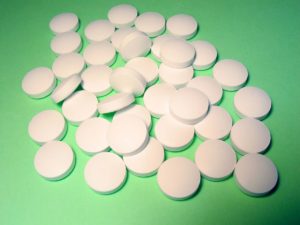 A variation of this study - intermittent fasting (one day eat normally, then have a low-calorie day, repeat) has shown to result in health benefits and weight loss. But both versions show that having some low calorie days are beneficial to health. And once again, antioxidants do not have any health benefits. From Science Daily:
A variation of this study - intermittent fasting (one day eat normally, then have a low-calorie day, repeat) has shown to result in health benefits and weight loss. But both versions show that having some low calorie days are beneficial to health. And once again, antioxidants do not have any health benefits. From Science Daily:
Feast-and-famine diet could help extend life, study suggests
University of Florida Health researchers have found that putting people on a feast-or-famine diet may mimic some of the benefits of fasting, and that adding antioxidant supplements may counteract those benefits.
Fasting has been shown in mice to extend lifespan and to improve age-related diseases. But fasting every day, which could entail skipping meals or simply reducing overall caloric intake, can be hard to maintain..."We started thinking about the concept of intermittent fasting.”
Michael Guo, a UF M.D.-Ph.D. student who is pursuing the Ph.D. portion of the program in genetics at Harvard Medical School, said the group measured the participants’ changes in weight, blood pressure, heart rate, glucose levels, cholesterol, markers of inflammation and genes involved in protective cell responses over 10 weeks.“We found that intermittent fasting caused a slight increase to SIRT 3, a well-known gene that promotes longevity and is involved in protective cell responses,” Guo said.
The SIRT3 gene encodes a protein also called SIRT3. The protein SIRT3 belongs to a class of proteins called sirtuins. Sirtuins, if increased in mice, can extend their lifespans, Guo said. Researchers think proteins such as SIRT3 are activated by oxidative stress, which is triggered when there are more free radicals produced in the body than the body can neutralize with antioxidants. However, small levels of free radicals can be beneficial: When the body undergoes stress -- which happens during fasting -- small levels of oxidative stress can trigger protective pathways, Guo said. “The hypothesis is that if the body is intermittently exposed to low levels of oxidative stress, it can build a better response to it,” Wegman said.
The researchers found that the intermittent fasting decreased insulin levels in the participants, which means the diet could have an anti-diabetic effect as well.
The group recruited 24 study participants in the double-blinded, randomized clinical trial. During a three-week period, the participants alternated one day of eating 25 percent of their daily caloric intake with one day of eating 175 percent of their daily caloric intake. For the average man’s diet, a male participant would have eaten 650 calories on the fasting days and 4,550 calories on the feasting days. To test antioxidant supplements, the participants repeated the diet but also included vitamin C and vitamin E.
At the end of the three weeks, the researchers tested the same health parameters. They found that the beneficial sirtuin proteins such as SIRT 3 and another, SIRT1, tended to increase as a result of the diet. However, when antioxidants were supplemented on top of the diet, some of these increases disappeared. This is in line with some research that indicates flooding the system with supplemental antioxidants may counteract the effects of fasting or exercise, said Christiaan Leeuwenburgh, Ph.D., co-author of the paper and chief of the division of biology of aging in the department of aging and geriatric research.“You need some pain, some inflammation, some oxidative stress for some regeneration or repair,” Leeuwenburgh said.
On the study participants’ fasting days, they ate foods such as roast beef and gravy, mashed potatoes, Oreo cookies and orange sherbet -- but they ate only one meal. On the feasting days, the participants ate bagels with cream cheese, oatmeal sweetened with honey and raisins, turkey sandwiches, apple sauce, spaghetti with chicken, yogurt and soda -- and lemon pound cake, Snickers bars and vanilla ice cream.

 I am starting to read more and more negative comments from physicians and researchers about the big pharma and medical society recommendations for treating currently healthy people with
I am starting to read more and more negative comments from physicians and researchers about the big pharma and medical society recommendations for treating currently healthy people with  Bottom line: try not to eat processed sweetened foods or drink sodas because high intake is linked to type 2 diabetes. Several studies point the finger in particular to high fructose corn syrup, which is the most frequently used sweetener in processed foods, particularly fruit-flavored drinks and soda. An earlier 2013 study from Europe found that drinking one 12-ounce sugar-sweetened soft drink a day can increase the risk of type 2 diabetes by 22%. Instead eat real whole foods like fruits and vegetables. From Medscape:
Bottom line: try not to eat processed sweetened foods or drink sodas because high intake is linked to type 2 diabetes. Several studies point the finger in particular to high fructose corn syrup, which is the most frequently used sweetener in processed foods, particularly fruit-flavored drinks and soda. An earlier 2013 study from Europe found that drinking one 12-ounce sugar-sweetened soft drink a day can increase the risk of type 2 diabetes by 22%. Instead eat real whole foods like fruits and vegetables. From Medscape: I feel like I'm posting the same thing over and over as study after study finds the same or similar results. Bottom line: sitting much is bad for health, so get up and move (walks are good). The more you move or exercise, the better for health.
I feel like I'm posting the same thing over and over as study after study finds the same or similar results. Bottom line: sitting much is bad for health, so get up and move (walks are good). The more you move or exercise, the better for health. Bottom line: Try to avoid artificial sweeteners!
Bottom line: Try to avoid artificial sweeteners! Are probiotic bacteria the reason?
Are probiotic bacteria the reason? Another reason to eat vegetables, whole grains, seeds, fish, and nuts - they provide magnesium. From Medical Xpress:
Another reason to eat vegetables, whole grains, seeds, fish, and nuts - they provide magnesium. From Medical Xpress: The link between pesticide exposure (pesticides used in the home or in the garden or lawn) and childhood brain tumors has been known for years. From Science Daily:
The link between pesticide exposure (pesticides used in the home or in the garden or lawn) and childhood brain tumors has been known for years. From Science Daily: